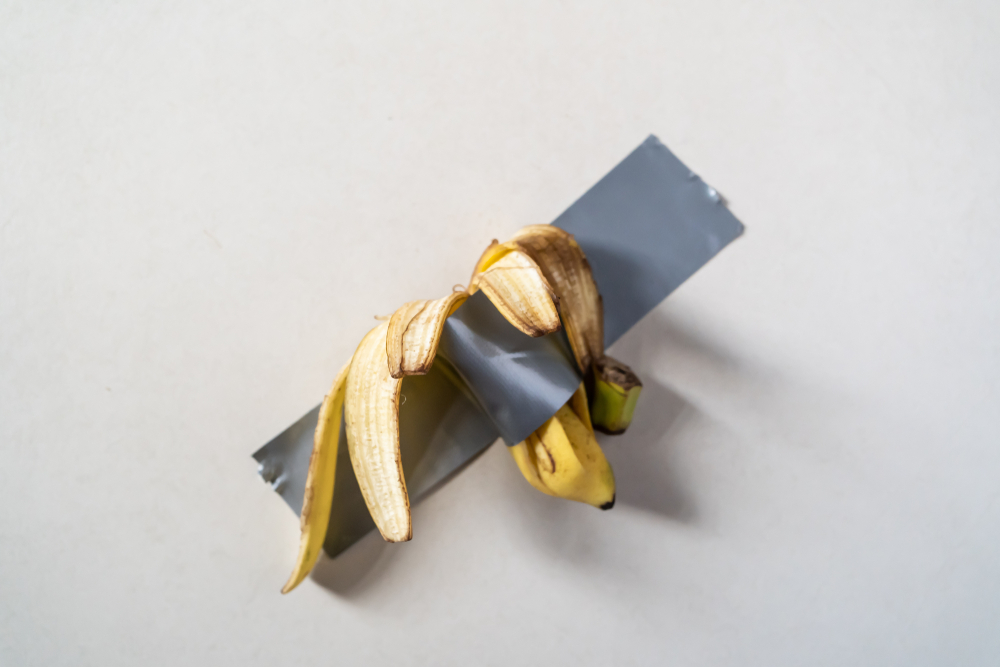As political and cultural commentator P.J. O’Rourke said, “Like most sensible people, you probably lost interest in modern art about the time that Julian Schnabel was painting broken pieces of the crockery that his wife had thrown at him for painting broken pieces of crockery instead of painting the bathroom and hall.”
I never thought of P.J. O’Rourke as a prophet, but I’m beginning to reevaluate that premise as on a regular basis the art world continues to perplex and astound me. And it’s not because I’m seeing some brilliant object of beauty that burst forth from a creative mind to a skillful hand, it’s more the opposite.
It seems every step forward I make to not become that grumpy old man shaking his cane at the current state of popular culture, something happens, and I take two steps backward toward that rocking chair.
Who can blame me when we learn an “artist” — and come on, we must admit this is the loosest use of the term — duct taped a banana to a wall and called it finished.
Now, maybe the alleged artist was trying to make some kind of backward commentary on the ridiculousness of many strains of modern art … but I think not in light of the following news that someone paid $120,000 for the banana duct taped to a wall.
Imagine what the artist could have gotten if he had duct taped an entire bunch of bananas, or maybe a watermelon. If the art was sold by the pound, he could have come away with a million dollars.
As I rocked back and forth in my rocking chair wondering about the likes of these things and if the Dodgers will ever win another World Series, the duct-taped-banana-to-a-wall art project got even more bizarre.
Apparently a self-described “performance artist” visited the gallery where this rendering of the genus “musa acuminata” (that’s the fancy scientific name for bananas. I don’t know what the fancy scientific name is for duct tape, unfortunately) and commenced to eat the art.
The police, the person who purchased the “art” and has the letter of authenticity to prove it, and the gallery have all been left in a quandary. Do they charge the performance artist with destruction of private property, willful vandalism of art, or the violation of the “no eating in the gallery” rules? Is the violation to be found in the penal code or health department standards?
By the time this article finds the light of day I would not be surprised if the eating of the “art” was part of some uber-edgy performance artistic expression cooked up by both the taper of the banana to the wall and the “culprit” who used the art to get his FDA recommended intake of potassium.
But even if that is the “surprise” ending to this story and the media and all of its consumers like me are the brunt of the joke, the disappointing fact remains that despite people saying a few things on social media, no mainstream art critic I could find called “foul” on something so patently ridiculous.
Art is supposed to be about the pursuit of beauty and truth, in much the same way as other, less artsy human endeavors, like science, for example. As much as we’d like to fill in our own blanks regarding the incarnate God whose birth we are about to celebrate, the reality remains that as profound and universe-shattering the coming of a Savior is, it all took place within the constraints of time and in a very specific order.
If we do not know the Ark of the Covenant and what it held, we cannot know Mary as the new “ark” where the word was made flesh on our behalf, and where thousands of years’ worth of prophecy and exactness in the Old Testament comes to fruition in the God-made-Man.
And what does that have to do with art? Maybe more than we want to think about. If art is anything to anyone then art is nothing. If Jesus is anything we need him to be, he isn’t the Savior of the world the constant Father promised.
Is it always a straight line? Yes and no, kind of like real art and real life. Art, like faith, must point to the truth. For faith we have Scripture and Tradition: the eternal design. When art reflects purpose and design and human creativity it touches on the divine. When we draw outside these lines, when we stand in awe at a piece of fruit taped to a wall, we invite chaos, and that way madness lies.

